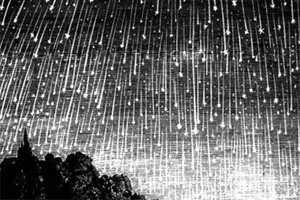 An 1833 depiction of the Leonid Meteor ShowerWhenever a sizeable meteor shower comes around—such as the annual Perseid show, peaking on the night of August 12/13—my attention is drawn to the notion of space dust, and star stuff, and Earthly versus cosmic provenance for what may otherwise be considered, mundanely, dust.
An 1833 depiction of the Leonid Meteor ShowerWhenever a sizeable meteor shower comes around—such as the annual Perseid show, peaking on the night of August 12/13—my attention is drawn to the notion of space dust, and star stuff, and Earthly versus cosmic provenance for what may otherwise be considered, mundanely, dust.
Each year at this time, Earth plows through a belt of dust left behind by the periodic passage of comet Swift-Tuttle, causing a significant bump in the number of meteors that might be seen. We usually think of shooting stars—meteors—as bits of dust or small pebbles that fly into Earth's atmosphere at high speed and are vaporized in a blaze of glory by their flight of friction.
In reality, it's the Earth running into the dust specks, not the other way around. It's a bit like a car on a freeway speeding through a cloud of insects, if you think of the windshield as the Earth's atmosphere and the smears and streaks of "bug guts" as the flashy demise of meteors. Earth's orbital speed is about 18 miles per second, which explains the fast and fiery trajectory of shooting stars.
But what happens to the material in the meteor after its luminous tail fades? Well, what do you think? It's a trail of dust high in the atmosphere: eventually, it is pulled to Earth, like any other dust particles, and settles down around us, invisibly, to become part of the landscape, and part of the air we breathe.
